The piece of the month of June 2013
PORTRAIT OF DON JOSÉ JULIÁN ARANGUREN, ARCHBISHOP OF MANILA, IN THE CONVENT OF THE AUGUSTINIAN RECOLLECTS OF MARCILLA
Esther Elizalde Marquina
Chair de Patrimonio y Arte Navarro
The upper cloister of the Augustinian Recollect convent of Marcilla houses an interesting collection of portraits of illustrious personalities of the religious order, begun in the 19th century, when the community took possession of the monastic complex, and continued uninterruptedly to the present day. Although their artistic value is very variable, they have an undeniable historical value, since all of them are identified both by inscriptions and heraldry.
Among these, one corresponding to the Archbishop of Manila José Julián Aranguren (1801-1861) stands out with its own light. He was born in the current Parish House of Barásoain, where he lived until 1818, when he went to the University of Zaragoza to study Law. Six years later he enlisted in the army as a cavalryman. This military adventure led him to rethink his life, taking the Augustinian Recollect habit in December 1825 in the high school of Alfaro and definitively renouncing his academic degree program .
After being ordained priest in Zaragoza two years later and obtaining the degree scroll of Lector, he was appointed President of the first mission statement of the Religious of the high school of Monteagudo in the Philippines (mission statement XXXIV), arriving in the port of Manila in April 1829. Once installed in the Philippine Islands, his priestly degree program was unstoppable. At first he dedicated himself to the reading of the Sacred Theology in the house of programs of study of the Recollects in Manila intramuros, as well as to the learning of the language "Tagalog" or "Tagalog", base of the present Filipino, to be able to communicate with the natives and to educate them in the Christian faith. This served him well in his work as a Missionary Priest of Capas in 1831. At the Provincial Chapter of the Order in 1834, he was elected Provincial Secretary of the Recollect Missions in the Philippines. He also became position of the spiritual administration of the Masinloc people from 1835 to 1843. He was appointed Prior board member of the parish of Baclayon and Vicar Forane of the Province of Zambales in the Chapter of 1837. Three years later, the Augustinian Recollects appointed him Definitor of the Province of Manila, and in 1843 he was elected Prior Provincial, a mandate that allowed him to revise the Methods of Administration for the Recollect Fathers in the Philippines, a text that may be the great success of his life as a missionary.
Described as an honest and respectable religious, his merits in the Philippines were brought to the attention of the civil authorities and the high ecclesiastical hierarchy. In this way, Queen Elizabeth II chose him to occupy the metropolitan see of Manila by Royal Decree of November 16, 1845, being preconized on January 19, 1846 by Pope Gregory XVI as Archbishop of Manila and consecrated in the Church of P.P. Recoletos in that city on January 31, 1847.
According to the documents reviewed, his work as archbishop was magnificent, leaving an important series of books on government, as well as a "Tagalog" version of Christian doctrine, among other texts. At the same time, he was in charge of the Philippine Canon Law and overseas public law, a facet for which he is also known. He was also the manager of the establishment of the Sisters of Charity in the Philippines in 1852 and the founding of the Banco Español-Filipino in 1851, the present Central Bank of the Philippines.
His loyalty to the Spanish crown was rewarded with the awarding of the Grand Cross of Isabella the Catholic, and with the appointment of senator for life by Royal Decree of September 19, 1951, although he did not accept it. After falling ill, he died in Manila on April 18, 1861.
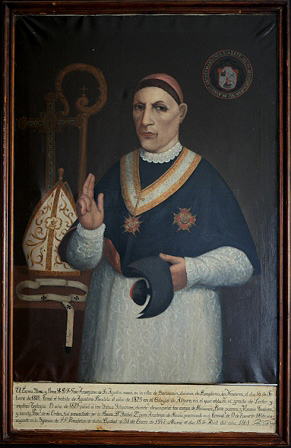
Portrait of D. José Julián Aranguren, Archbishop of Manila.
Convent of Augustinian Recollects. Marcilla
The canvas that sample to Father Aranguren is of considerable dimensions and it is trimmed in its part leave, where the accrediting registration is incorporated on a piece of painted wood: "El Excmo. José Aranguren de Sn Agustín was born in the town of Barasoain, diocese of Pamplona, in Navarra, on February 16, 1801. He took the Augustinian Recollect habit in the year 1825 in the high school of Alfaro, where he obtained the Degree of reader and explained Theology. In the year 1829 he went to the Philippine Islands, where he held the offices of Missionary, Parish Priest and Vicar Forane, and being Provl. of his Order, he was presented by the Queen Dª. Isabel 2ª. for Archbishop of Manila, preconized in the Consistº. of January 19, 1846, consecrated in the Church of P.P. Recoletos of the said City on January 31, 1847. He died on April 18, 1861".
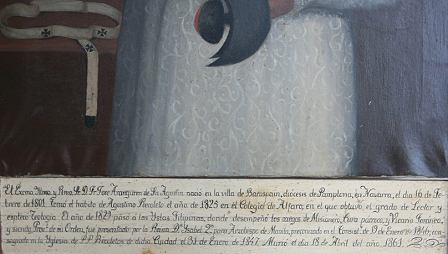
Portrait of D. José Julián Aranguren, Archbishop of Manila. Detail
As far as the iconography is concerned, it presents the archbishop in three quarters, observing the spectator with a cold and reflective expression, wearing a false hairpiece on his head, that is, a variety of wig that Father Aranguren used to conceal his baldness. He is dressed as a pontifical, with a roquette, black muceta and pectoral cross, blessing with his right hand, while holding the hood with his left hand. Also, the Great Cross of Isabella the Catholic, which has been previously made reference letter, can be seen, both as a veneration on the chest, and as a necklace with its corresponding band, in yellow gold and white. Next to it, on a neutral background, is a buffet on which rest other episcopal attributes such as the pallium, the crosier and the mitre, whose central decorative motif is the Augustinian anagram. Finally, there is an altar cross set with emeralds.
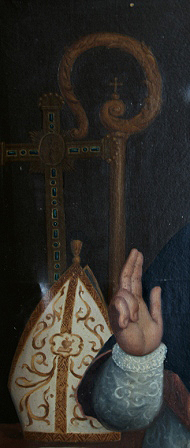
Portrait of D. José Julián Aranguren, Archbishop of Manila. Detail
In the upper right part of the composition we find the heraldry of Archbishop Aranguren, with the capelet and the twenty tassels, corresponding to his dignity. In it a church can be seen, perhaps making reference letter to his condition of head of the Church in the Philippines; the Augustinian emblem, with the book and the inflamed heart crossed by an arrow; likewise, a lily, attribute of the Province of San Nicolas de Tolentino, where the mentioned archipelago was inscribed. All this is surrounded with the legend in Latin: "D. D. F. R. JOSEPH. ARANGUREN. ORDIN. DISC. P. N. AUGUST. ARCHIEP. MANILENCIS".
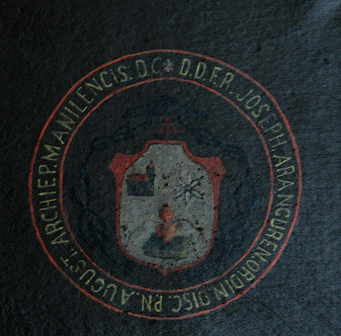
Portrait of D. José Julián Aranguren, Archbishop of Manila. Detail
As far as the execution is concerned, the painting does not present great quality, pointing more to the authorship of an Augustinian friar of the convent itself amateur painter, something usual in this collection of portraits, than to a professional artist. There is also no evidence of any signature and it is very likely that if there had been one, it would have disappeared, because as mentioned above, the composition was mutilated in its lower part in order to insert the biographical registration transcribed above.
In spite of this, the finding of the graphic source of Filipino origin that inspired the composition, a lithograph published by the periodical "Ilustración Filipina", gives us a postquem date (1860), placing the painting in the third quarter of the 19th century. It is one of the earliest magazines published in the Asian archipelago. Although it survived only twenty months and had forty-four issues, it stood out for the presence of high quality lithographic engravings, accompanied by the typography of "the charms of the artist's burin", which portrayed the history, landscapes and customs of its inhabitants.
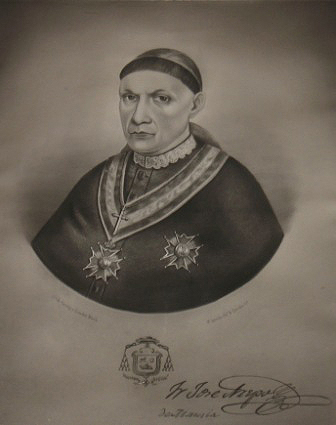
Portrait of D. José Julián Aranguren, Archbishop of Manila
Lithograph where the portrait painted by Marcilla was inspired.
The lithograph, of large dimensions (22 x cm.), appeared in the penultimate issue of the magazine (nº 23), on December 1, 1860, a few months before the death of the illustrious barasoaindarra. It repeats exactly the same outline of the explained canvas, both in the composition and in the rictus of the archbishop, so it is clear that this one was inspired in the Philippine incision. The main difference is that Marcilla's portrait was developed in three quarters and the episcopal attributes were incorporated on the buffet, although the lithograph presents a more developed heraldry, incorporating the Great Cross of Isabella the Catholic, as well as a variation, replacing the lily with a star, an attribute of Saint Nicholas of Tolentino. In it, the archiepiscopal capelet is also glimpsed on the back of the portrayed, something that on the other hand is not seen in the canvas, where it was replaced by the hood.
At this point it is necessary to value the source described here, since no photographs of the prelate are preserved, most probably because there were none, since the first photographic establishment in the Philippines that popularized the visit cards was founded by the British Albert Honnis in 1865. The lithograph of the magazine must have circulated as a photograph, a fact that explains why a copy, which remained in the hands of his family until well into the 20th century, is preserved today in the "Hogar Santa Elena" of his native town. One of them must also have reached the Augustinian community, where some advanced friar was inspired by it to make the composition that is preserved today in the convent of Marcilla.
Fortunately, and as is usual, the engraving presents marks of authorship, which make reference letter both to the draftsman and the lithographer, as well as to the establishment where it was printed. The original drawing was made by Manuel Garrido, literary editor and famous journalist, specialized in Philippine folklore and costumbrismo and characterized by an affable and sometimes caricaturist style. He collaborated in publications of great interest, such as the Official bulletin of the Philippines or the Diario de Manila. The portrait of Archbishop Aranguren was the writer's only contribution to the magazine. As for the engraver, he was Baltasar Giraudier, a Catalan journalist and businessman, author of eight of the drawings and fifty-three of the lithographs published in the magazine. Probably trained with the German Jorge Oppel, the first lithographer established in Manila in 1858, he stood out more for his facet as a draftsman and engraver than for his few monographs and literary contributions to Philippine periodicals, among them the Diario de Manila, of which he became director.
Likewise, it reflects the printing press where it saw the light, which is the same one where the rest of the publication was printed, the "Imprenta y Litografía de Ramírez y Giraudier". Of the latter we have already given a few glimpses; of its associate and co-owner printer, Manuel Ramírez little is known. After his death, the name and company name of the establishment was maintained until 1887, when Giraudier left the company and it was renamed "Ramírez y Compañía". Located at 10 Beaterio Street in Manila, its presses published periodicals such as the Diario de Manila, the Gaceta de Manila, the Revista de Filipinas or the bulletin de la Sociedad de Amigos del País, as well as more than a hundred monographs, including dictionaries, on various subjects such as history, geography, customs, medicine, industry, commerce and religion.
bibliography
- BALILI, PEDRO Fr., Monseñor José Aranguren (1846-1861): his life, time and pastoral action, Pamplona, 1992, [thesis doctoral defended at the University of Navarra].
- CARCELLER GALINDO, MANUEL (O.A.R.), Historia general de la Orden de Agustinos Recoletos de la Provincia de San Nicolás de Tolentino de Filipinas, 1967.
- MARTÍNEZ CUESTA, ÁNGEL (O.A.R.), Marcilla. Convento de Agustinos Recoletos (1865-2002), Zaragoza, Augustinian Recollects. Province of San Nicolás de Tolentino, 2002.
- RUIZ DE SANTA EULALIA, LICINIO (O.S.A.), Sinopsis histórica de la Provincia de S. Nicolás de Tolentino de las Islas Filipinas de la Orden de Agustinos Recoletos Descalzos, Manila, Tip. Pont. de la Univ. de Sto. Tomas, 1925.
- SÁDABA DEL CARMEN, FRANCISCO, Fr., Catalog de los religiosos agustinos recoletos de la Provincia de San Nicolás de Tolentino en Filipinas, Madrid, Asilo de Huérfanos del Sagrado Corazón de Jesús, 1906.
- SANTIAGO VELA, GREGORIO DE (O.S.A.), essay de una Library Services ibero-americana de la Orden de San Agustín, Madrid, Asilo de Huérfanos del Sagrado Corazón de Jesús, 1920.
- SIERRA DE LA CALLE, BLAS (O.A.R.), La ilustración filipina (1859 - 1860), Valladolid, Caja Duero, 2003 [Catalog de exhibition].
- WENCESLAO RETANA, EMILIO, El periodismo filipino: Noticias para su historia (1811-1894) Apuntes bibliográficos, indicaciones biográficas, notas críticas, semblanzas, anécdotas, Madrid, Viuda de M. Minuesa de los Ríos, 1895.
